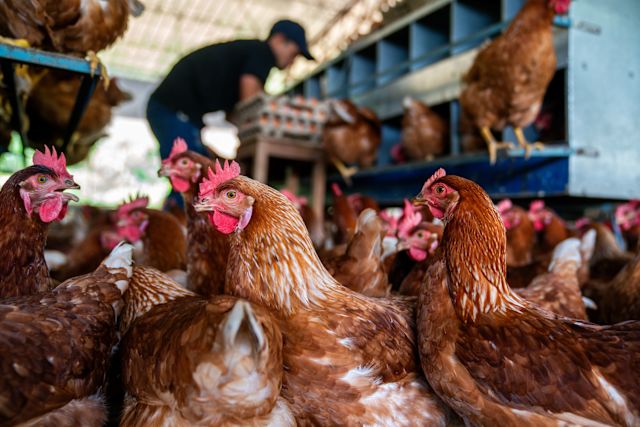Updated on March 4, 2025.
At least 70 human cases of A(H5N1) “bird flu” have been reported since 2024, and one person from Louisiana has died from the infection, according to the Centers for Disease Control and Prevention (CDC). It’s the first confirmed death from the virus in the United States. Around the world, however, more than 950 cases of bird flu have been reported to the World Health Organization (WHO), and roughly half of those cases were fatal.
The current outbreak began in late March 2024 with the detection of A(H5N1) in dairy cows. With COVID in the not-so-distant past, should we be concerned about another human pandemic?
What is H5N1 “bird flu”?
Bird flu is very different from the flu viruses that spread among people most commonly in the fall and winter months. There are four types of influenza viruses that infect people: A, B, C, and D. Bird flu is caused by avian influenza A viruses that usually spread between birds—not people.
One subtype of bird flu known as A(H5N1) is spreading around the world among wild birds. This virus can spread to other mammals as well, including dairy cattle, poultry flocks, and other wild animals that may be exposed to or eat infected birds or poultry. This may include:
- Wild animals, such as seals, bears, foxes, skunks
- Farmed mink
- Stray or domestic animals, such as cats and dogs
- Zoo animals, such as tigers and leopards
The virus spreads among animals through their mucus, saliva, or poop. Only rarely does bird flu infect people. To date in the U.S., human cases have only resulted from prolonged and unprotected exposure to infected animals. And nearly all infections involved in the current outbreak are tied to dairy cattle and poultry farms.
How do people catch bird flu?
In some rare cases, bird flu has spread from mammals to people, which is why the CDC is closely monitoring the virus and how it is behaving. But the people who have gotten bird flu were infected through direct contact with infected sick or dead animals. It’s also possible to become infected through exposure to surfaces where there are contaminated animal secretions.
Another way people can get bird flu is by eating undercooked or raw poultry or eggs that are contaminated or drinking raw (unpasteurized) milk from infected dairy cows. (Eating properly cooked or pasteurized products is safe.)
So, people at higher risk for bird flu typically include:
- Poultry and dairy and other livestock farmers and workers
- People who own wild birds
- Veterinarians and veterinary staff
- Animal health responders
- Public health responders
- Dairy laboratory workers
- Anyone who handles raw milk and other confirmed or potentially contaminated materials
- Slaughterhouse workers exposed to lactating dairy cattle
- Zoo or other wild animal facility workers
- Wild animal rehabilitation center workers
- Hunters
How do people know if they have bird flu?
Like many other viruses, bird flu can range from very mild to severe. So far, most human cases in the United States have been mild.
Some people who are infected have had no symptoms. In many cases, however, one of the first signs is eye irritation, tearing, or redness. Other symptoms people may develop include:
- Fever or chills
- Cough
- Sore throat
- Shortness of breath
- Headaches
- Runny or stuffy nose
- Muscle or body aches
- Fatigue
Less often, people may also develop diarrhea, nausea, or vomiting.
Symptoms of bird flu may develop up to 10 days after exposure to the virus. Anyone who suspects they’ve been exposed to bird flu and has any of these symptoms should contact their healthcare provider (HCP) as well as their state or local health department.
People with a suspected infection can be tested for H5N1. Since bird flu is a virus, antibiotics (which treat bacterial infections) will not help. Treatment for viruses usually involve supportive care, such as rest, fluids, and over-the-counter pain medications, like acetaminophen (Tylenol, Aleve, etc.) or ibuprofen (Advil, Motrin, etc.)
There are antiviral medications that could help ease the severity and duration of bird flu. But these drugs are most effective when given immediately after exposure to the virus or once symptoms develop. It’s also very important to take antiviral medications as directed.
Is bird flu something to worry about?
U.S. health officials say the current risk to public health due to bird flu is low. The CDC, however, is closely monitoring the virus. There are no confirmed U.S. cases of bird flu spreading from one person to another, but this has been reported in other countries. So far, however, this spread has been self-limiting—the virus did not continue to spread among more people.
But scientists will closely watch how the virus behaves. This can help them anticipate if the virus is mutating or evolving to spread more easily—either from animals to people or from one person to the next. They will also be watching to see if the virus is evolving to be more resistant to existing antiviral medications that can help manage the infection.
How to prevent bird flu infection
Knowing how bird flu spreads can help people avoid infection. Some steps you can take right now include:
- Avoid direct contact with wild birds.
- Do not touch sick or dead birds or other animals.
- Avoid exposure to animal feces or litter.
- Avoid contact with any surface or water source (ponds, pans, troughs, etc.) that might be contaminated with animal saliva, feces, or other bodily fluids without wearing personal protective equipment (PPE).
- Do not allow pets to have contact with wild birds or other animals that are alive or dead.
- Consume pasteurized milk and products made with pasteurized milk. Pasteurization kills harmful bacteria and viruses, including E. coli, Listeria, Salmonella, and A(H1N5)—the virus that causes bird flu.
- Properly cook poultry, eggs, and beef to kill bacteria and viruses.







